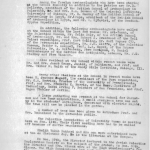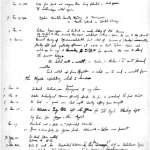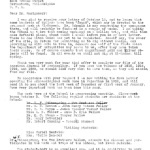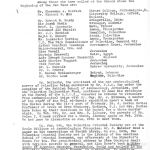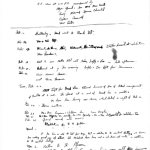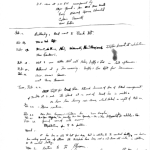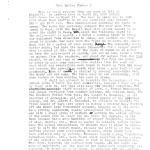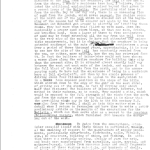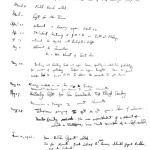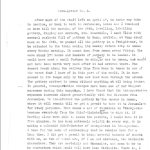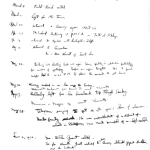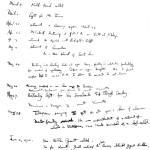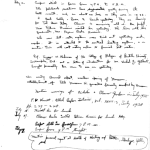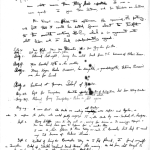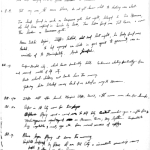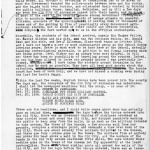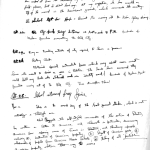EXPLORE BY MONTH
January | February | March | April | May | June | July | August | September | October | November | December
—1938—
—January—
Newsletter No. 1. [printed document]
Among the foreign archaeologists who have been staying at the school recently in addition to the Petries ar Mr. D. Bellerby, architect of the British School of Archaeology in Palestine, Dr. and Mrs. R.A. Bowman of the Oriental Institute, University of Chicago, Dr. E. Mackay of the British School of Archaeology in Egypt, and Mr. K. Sjöqevist, of the Swedish Cyprus Expedition.
In addition, the following archaeologists have called at the School within the last few weeks: Mr. Avi-Yonah, of the Palestine Museum, Mr. Colin Baly, of the British School of Archaeology, Mr. and Mrs. Robert J. Braidwood of the Tell Tainat expedition, Prof. Kurt Galling, Mr. Carl Haynes (?) [sic] of the Persepolis expedition, Mr. J.H. Iliffe, of the Palestine Museum, Father R. Koeppel, Prof. L.A. Mayer, of the Hebrew Univeristy, Dr. A. Reifenberg, Pere Saragnae, M. Daniel Schlumberger of the Service des Antiquities, Lebanon, Mr. J.L. Starkey and Pere Vincent.
Also resident at the School within recent weeks were Mr. and Mrs. Jacob Gross, Junior, of Baltimore, and Prof. and Mrs. Wilbur M. Smith of the Moody Bible Institute, Chicago, Ill.
Among other visitors at the School have been M. Jacques Bagard, the architect of the Dura expedition, Mr. C.A. Herrick, Trustee at the University of Pennsylvania, Prof. and Mrs. Frederic K. Morris, of the Mass. Institute of Technology, Rabbi Irving F. Reichert of San Francisco, and Prof. Eugen Täuber of Berlin.
A large gathering was present at the School for Christmas and New Year celebrations. A small evergreen tree was set up in the students’ living room, decorated with electric lights. The tree will now be planted in the garden.
A number of teas has been given to introduce Prof. and Mrs. McCasand to the Jerusalem public.
The Palestine Association of University Women is meeting here on Jan 11th. Their First meeting here had to be cancelled off because of curfew regulations.
Sheikh Yakub Bukhari and his son were entertained here at tea on Christmas day. He is the librarian at the Mosque.
On Dec. 29th, the Director lectures to the Jewish Palestine Exploration Society on the subject of the Arabah. On Dec. 30th, the Director and Mrs. Glueck were at the High Commissioner’s for dinner. The High Commissioner had just returned from visiting the excavations at Khirbet et. Tannur, accompanied by Mr. Hardin, and expressed the desire to see the objects found when they are displayed at the American School. It is planned to hold an exhibition of the Khirbet et-Tannur sculptures at the American School in February.
Between Nov. 29th and Dec. 12th 1937 a second, concluding campaign of excavations was undertaken at Khirbet et.-Tannur. The temple-complex has now been completely exposed. Among the finds may be mentioned in particular another Zeus-Hadad head, showing Hellenisting and Parthian influences. Mr. Jacob Gross, Junior donated $20 to be used at the Director’s discretion. The Director is using the gift to pay for photographs of Kh. Et-Tannur objects. The concluding excavations at Kh. Et-Tannur were made possible by the gift of $250.00 made by Mr. Henry J. Patten, a member of the Board of Trustees of the Schools.
The livingroom of the School has been renovated at a cost of some L.P. 45.
The surplus in January Hostel statement after the payment of all large outstanding bills is L.P. 690.173.
About 65 fruit and evergreen trees are being planted in the garden.
Miss Frances J. Olcott, New York City, has registered for the Jan-March term.
The Museum has presented us with a complete copy of its Library Catalogue.
The political situation remains in a state of chronic disturbances.
January 3
Miss Frances J. Olcott, registered for remainder of course of lectures. Dr. Brawer called; Dr. Suberik called.
January 4
Sixty five fruit and evergreen trees being planted in back garden. Mr. Schlumberger called again.
January 5
Palestine Oriental Society Meeting at Dominicans. Dr. Maisler lectures on Sheikh Ibreik.
January 10
Lectures began again. I lectured on early history of Kh. Tannur. Mr. Michael M. Rix, University colleague, Oxford, anthropologist working in Cyprus, has come to stay with us for a few days.
Formal preview of Museum scheduled, but called off because of Starkey’s assassination. Starkey shot dead yesterday afternoon at 5 P.M. on Beit Jabrin – Hebron road while on his way to Jerusalem to Iliffe’s for dinner. He was to attend the preview today. The school sent a wreath, and Fisher, and Helen and I sent personal wreaths. Loud called up from Megiddo and asked me to send a wreath for the Megiddo expedition, which I have done.
Sukenik lectures on “ancient Synagogues” to my class.
January 13
Palestine Archeological Museum officially opened. For fun, I purchased the first ticket.
January 14
We had a good rain last night. Country suffering from drought.
January 15
Sir Flinders and Lady Petrie left with Ylias for Tell Ajjul. Mackay left by train for Gaza and then Ajjul.
January 17
Steinbeck read a paper on “Unfinished Miracles.” Gave a dinner party for Gordon Loud. Wadsworth and Adlers were present.
January 25
Sir Aurel Stein called. Dinner at H. E.
January 26
P.O.S. met here. Presidential address by Pere B. Couronyer [?] O.P, N.G. on Nabetaean Syria and Nabataean T.J.; St. H. Stephan on Arabic terms, Sheikh Alreiq, etc. [sic] Palestinean Saints and Sanctuaries with Nicknames.
January 28
Leaving for Alexandria.
—February—
February 5
Returned from Egypt with Mother and Dad. I am member of Board of Trustees of N.S.M. J. P.O.S. Dr. and Mrs. Doris of Drew Serrvisay here.
February 8
Kirkman here for several days.
February 10
2:30 P.M. every road-turn guarded by armed British soldiers, 2 standing in our front door, and one in the back entrance. H.E. came at 3:30 P.M. accompanied by Major General and Mrs. And Miss Warrall, Lady Edward Spencer Churchill, Captain Cresswell, Miss Poston.
February 11
Bellerly and Reed went to Flenk Mt.
February 13
Newsletter No. 2. [printed document]
Among those who have called at the School since the beginning of the New Year are:
Mr. Cheesman A. Herrick Girard College, Philadelphia, PA.
Mr. Michael M. Rix University College, Oxford, England.
Mr. Robert S. Hardy Grangeville, Idaho
Sir Aurel Stein Srinagar, Kashmir
Prof. L. Hennequin Metz, France
Mohammed Ali Majairi Amman, Transjordan
Mr. J.W. Hawkins Rammallah, Palestine
Najib S. Khoury Jenin, Palestine
Mr. Lankester Harding Amman, Transjordan
H.E. The High Comissioner of Palestine, General Sir
Arthur Grenfell Wauchope Government House, Jerusalem
Major-General, Mrs. and Miss Wavell Jerusalem
Captain Creswell Cairo, Egypt
Lady Edward Spencer Churchill England
Lady Charles Teggart Jerusalem
Miss Poston Jerusalem
Dr. L. Sukenik Hebrew University, Jerusalem
Dr. D. Brawer
Mr. Daniel Schlumberger Beirut, Lebanon
Mr. Gordon Loud Megiddo, Palestine
Mr. Bellerby, the architect of the new archaeological survey of Palestine being conducted by Mr. P.L.O. Guy under the auspices of the British School of Archaeology, Jerusalem, and the Palestine Exploration Fund, continues to make his residence at the Hostel of the A.S.O.R., whenever he returns to Jerusalem from archaeological trips with Mr. Guy. Mr.J. Kirkman, a member of the staff of the Tell ed-Dunweir expedition spent a week at the Hostel during the first part of February. Dr. J. Newton Davies Professor of Greek at Drew Seminary, Madison, N.J. and Mrs. Davies have taken upon their residence in the Hostel for a three months’ visit. On Feb. 5th, Dr. and Mrs. S. Iglauer, the parents of Dr. Helen I. Glueck arrived for a visit, leaving again on Feb. 13th. We had gone to Alexandria on Jan. 29th to meet them.
On Jan 5th, the Palestine Oriental Society let at the Ecole Biblique et Archéologique Française. Dr. B. Maisler read a paper on Nabataean Syria, and St. H. Stephan on Palestinian and Sanctuaries with Nicknames.
After the return of the School trip to Egypt, participated in by Prof. V.S. McCasland, and Mr. and Mrs. Reed, the second term of lectures began on Jan. 10th. On Jan. 12th Dr. L. Sukenik gave a lecture on “Ancient Synagogues.” Dr. M. Canaan is to give a lecture on Palestian Folklore.
On Jan. 13th, the Palestine Archaeological Museum, built as a result of the munificent Rockefeller gift, was officially opened. The ceremonial preview which was to have been held on Jan. 11th, with the participation of H.E. The High Commissioner was called off because of the brutal murder of Mr. Starkey, the Director of the Tell ed-Dunweir excavations. He was killed in the late afternoon of the previous day while on his way to Jerusalem. We went to his funeral instead of to the opening of the Museum. It is with deep melancholy that I notice his firm signature entered in our visitor’s book, on Dec. 24th 1937. The excavations are being continued under the direction of Charles Inge, and the supervision of the publication of the previous results. He is the best man that could possibly be found for the purpose, because of his close relationship with Starkey and the excavations at Tell ed-Dunweir, and because of his own competence. Before Starkey’s death, some new hieratic inscriptions had been found, and since then another ostracon. The four lines are written in ink on a fairly large sherd, which was found in quite a different position than the previously discovered Lachish entrance.
Excavation permits have been issued by the Palestine Department of Antiquities to Dr. B. Maisler to continue his excavations at Sheikh Abrein, and to Prof. Sellin and Mr. Stekeweh to undertake some additional clearances at Balatah. On Jan. 11th, Dr. Ernest Mackay, Sir Flinders and Lady Petrie, and other members of their staff left the School for another season of excavations at Tell Ajjul. The permit for the excavations is in Dr. Mackay’s name. The rains have prevented much work being done thus far. A letter from Dr. Mackay announces the death of Lady Petrie’s cat. The interesting feud between the cat and our dog takes thus an untimely end.
The unusually dry winter was brought to an end by a heavy rainfall on Jan. 14th. Since then the rains have been trying to make up for the lost time. On Feb. 11th, Jerusalem was covered with a mantle of snow for a couple of hours.
On Jan. 25th, the Director and Mrs. Glueck were at the High Commissioner’s for dinner. On Feb. 10th, His excellency accompanied by a large party, which included Major-General Wavell and Captain Creswell, visited the American School of Oriental Research, and viewed the exhibition of the Khirbet et-Tannur sculptures and architectural pieces, which Dr. Fisher had arranged in the library of the School. The exhibition is to remain on display for two weeks. H.E. General Sir Arthur Wauchope is retiring from his office at the end of this month. It is a matter of personal regret to us that this war-bitten general, who has the appearance and sensitive understanding of a poet, is leaving Palestine, after seven years of devoted services to this country. He has been extremely interested in the work of our school, and we are deeply indebted to him for active assistance and understanding encouragement.
Vincent de Vaux, Neal, Wadsworth, Hamiltons, and Iliffes present at exhibition. Miss Landau’s.
Went to new Kallia Hotel with Helen, Duffy and Leo in late afternoon.
February 20
Returned at g the morning [sic]. Duffy and Leo left for Damascus.
February 21
University Women’s Association. Met Caron Hanover.
Left for Dead Sea. Returned because of fear of Potash management of troubles at south and the island at north end of Dead Sea is visible. We have been having rain storms, which started in night of Feb. 22.
February 23
Mr. and Mrs. Leyons and 2 children here from Shanghai.
February 24
Storms continue.
February 25
Mr. and Mrs. Magnes, Mr. Horavitz, Mr. and Mrs. Agrinsky, and Mr. and Mrs. Fitzgerald here for exhibition and tea.
February 28
Ground covered with snow. Exhibition open to the public.
—March—
March 1
It has been so cold the last few days, that in addition to the central heating, we have been making general use of stoves. The McCaslands have been used 4 oil stoves all winter, in addition to the central heating.
March 2
Visitors to the Museum.
Palestine Oriental Society met in living room, with preview showing of antiquities in library. Harding staying here as my guest. Strong rains continue. Cisterns full. Class image of Tell Duweir. Undertook duraim [?] with Harding and Iliffe.
March 4
Ordered new shelves for the library.
March 7
See Announcement of the New Testament Club of U. of Chicago 1937-8.
March 8
Keith-Roach called.
March 11
Aqabah,
Tell el-Kheleifi
News Letter Number 3 [printed document]
This is being written from our camp at Tell el Khaleifi. We arrived here on March 14, 1938 having left Jerusalem on March 11. The road to Amman was in such poor shape that traffic on it was permitted only between 12:00 and 2:00 P.M. This necessitated spending the night in Amman. The rains had seriously damaged the road also from Amman to Maan, with the result that slow travel caused us to spend the night in Maan. We slept the following night in the police-post at Aqabah. I hired a special truck to bring our equipment from Jerusalem to Amman, and another one from Amman to Aqabah. Our cars were the first to traverse the Amman-Maan road in a period of over twenty days. The unusually heavy winter rains, had made the roads impassable for a longer period than is usual at this time of the year. On March 14 we moved on from the police-post at Aqabah, and set up camp about a hundred metres from the seashore, and about 450 metres from the tell itself. We put our camp so far from the mound, in order to gain some comparative shelter from the sand and dust which our excavations were bound to throw up from the mound and because the prevailing north wind blows a good deal of sand southward. Some of it was stopped by several sand-dunes between the mound and our camp. The dunes near us are stationary, with some bushes on them holding the sand in place.
I shall not attempt to describe the happenings at the school since I wrote the last newsletter, because I have not got my diary with me, but that will keep for another occasion. The staff consists of Prof. S. Vernon McCasland, our Annual Professor from Goucher College, Mr. William Reed, the Two Brothers Fellow from Yale, Mr. Ernes, F. Beaumont, an old resident of Jerusalem, and a former member of the American Colony, and Dr. Albert K. Henschel, in addition to myself. The first couple of days were spent in making a contour map, dividing off the mound into five-meter squares, hanging on to the tents in a driving sandstorm, making arrangement for water, etc. and with a small group of workers sifting the entire surface of the mound down to about ten cm. below the surface. We did that because there were hundreds of copper fragments, pieces of slag, sherds, etc. that we wanted to collect, before beginning the actual excavations. We thought that it might be necessary to sift the entire mound, because the sifting of the upper surface yielded such interesting results, which could have been achieved only by sifting. Numerous copper nails, fish-hooks, carnelian beads, etc., were found which testified to the nature of the articles we might expect to find in deeper excavations. That done, however, our hardest work began. All the walls are made of mud-brick, and the tops of the walls have completely decomposed. To carry on as we began, by scraping off the surface layer by layer, would have resulted in the total destruction of the walls. We would have found objects, to be sure, would have left a lamentable hole in the ground where once there had been an important small town. We therefore abandoned the scraping process and starting from the northwest corner, have by painstakingly slow and judicious sounding established where the walls of the rooms at the northwest corner were located. Once found, we follow the walls first, before removing the contents of the rooms. The process has been successful thus far, but it is a very slow one, and it is more than possible that we shall not be able to finish this season. At the present time, we are employing about thirty five workmen from Aqabah. I could easily dig up the whole mound in two or three weeks with 150 workmen, but with the present staff, 35 workmen are all that we can control, and it keeps us on the jump all day long. I shall also not be able to complete the excavations with the money at hand from the American Philosophical Society, and will need at least a thousand dollars more.
The results thus far achieved, are, I believe, fairly satisfactory, considering the fact that we did not actually begin to die until March 18. We have found a series of small funace and smelting rooms on the northwest slope of the mound, with flues in the walls. We have opened up one large room, which was full of slag, and had seven flues in one wall. Some of the rooms have what we think are the crucibles, in which the ore was smelted. Very few objects have been found in these rooms, but it is natural that in the rooms where the ore was smelted, very few objects should be found. The first Sunday, March 20, we took off as a rest day. Local sediment, however, has made it advisable to adopt, the custom which prevails at Megiddo and Tell ed-Dunweir and to take Friday off as our rest-day, so today too, we are not working. In the work-week, which begins tomorrow, we hope to get a lot accomplished. Although our general policy is to make haste slowly, the Arab proverb has it that “haste is from the devil” and with their rest-day, we have also adopted this proverb of theirs, so far as the methodical prosecution of our work is concerned. I shall not give any further details of our dig at present, but will send another news-letter in a couple of weeks. Furthermore, it is time to go to bed. We start work at 6 A.M. and it is now 9 P.M.
Dear Millar, The foregoing news-letter is for general information. Will you please have a copy of it sent to Albright. There is mothering else that that I want to add to it at the present moment, except to wish that you were here with us.
As ever, sincerely yours,
[signature absent]
—April—
Aqabah – Tell el Khelefi
News Letter 4. [printed document]
McCasland, Beaumont, and Henschel left today, returning to Jerusalem via Beersheba and Hebron, with a military escort. One of the machine-gun cars which arrived here yesterday is returning with them. Otherwise they would have had to take the road through Transjordan. A new road has just been opened from Mrashrash, (the police-post on the Palestine side of the Gulf of Aqabah), which goes straight along the west side of the sheba. By this road, Aqabah is only about ten hours by auto-mobile from Jerusalem, whereas the Transjordan route take fifteen hours, and is a much worse road. Were it safe to travel alone from Beershiba to Jerusalem, the distance between Jerusalem and our cm would not be as difficult to traverse as it is, and would be much cheaper for our cars. The three who left today had prior commitments which I knew abut before they came down here. Reed left about a week ago, being replaced by another student of the School, Mr. Emanuel Labes. There are about two more weeks’ work necessary before I bring the present season of work to a close. Above all, I must have an architect. I am making arrangements to bring one down in a few days to take Beaumont’s and Henschel’s place Some more le velling has to be done and a number of eleations. I shall only complete the digging of those rooms we have already opened up, using only a force of men small enough for Labes and me to control.
The close of the present season of work will mark the finishing of less than half of the mound area, and probably on a third of the area which extends around the mound and which is apparently nothing but sand. I am sure, however, from the experience gained this season, that the total area of the mound must be doubled, before we complete excavating it and the areas surrounding it, The work has been going at such an intense pace, that I have hardly had time to take stock, so to speak, even of our finds, let alone of our results. Suffice it to say, that the results and finds already obtained mark this site, (as small as it is when compared to the average site excavated in Palestine, and particularly to such place as Tell ed-Dunweir or Megiddo), as one of the most important opened up in recent years. I hope that somehow, sufficient funds will be found to enable the carrying out of a second campaign with a larger staff and more workmen. It was all the five of us could do this recording, planning, leveling, and photography, and some mending, – and that kept us busy from 5:30 A.M. when we started work till about 8 P.M. when we went to sleep. The staff did the extra work that was imposed on them most willingly, but it was a severe strain.
A number of problems has been settled by our excavations, and perhaps a larger number created. Before we are through with the work, we hope to be able to answer most of the questions that have presented themselves, and which are still require solution.
We still think that Tell el-Khaleifi is the site of Ezion-Geber. A problem that we previously dealt with is how to explain the distance of the tell from the seashore The tell is now 555 metres from the shore. A month’s residence here has, I believe, furnished the additional explanation required beyond that given in a recent issue of the Bulletin. The prevailing wind here is from the north. Day in and day out, there is an unceasing flow of sand from the Arabah, which moves seaward. The shallow rooms at the north end of the tell which we cleared out again by the time Beaumond and Henschel got around to planning and leveling these rooms. They had more than half filled up with sand. When occasionally a proper sand storm blows, so that one eats, drinks, and breathes sand, then a layer of three to five centimeters of sand may be found extending all the way from the tell down to the very edge of the water. We have not attempted any scientific measurements, but it is obvious that the seashore is being extended southward at the rate of ten centimeters a year. Over a period of three thousand years, approximately, it is easy to see how the site of the tell has constantly receded form the sea, or rather, more exactly, how the sea has retreated from it. In fact the builders of Ezlon-Geber could not have chosen a worse place along the entire seashore for building their city than the present site. It is situated almost exactly half way between the east and west ends of the Arabah, and exposed to the full blast of the winds from the north, and to the accompanying sand. We have had the experience of being in a sandstorm here at Tell el-Khaleifi, and then by the simple process of driving about four kilometres to Aqabah to the east, (which is in a less exposed position on the slope of the hills which stretch down to the edge of the gulf on the east side) of getting out of the storm. In fact by driving only about half that distance the builders of Ezion-Geber, howeer, had method in their madness, so to speak. They wanted a site, which would be exposed to the full strength of the winds from the north. And from the nature of some of the buildings it is clear that the prevailing winds say in the 10th and 8th century B.C. were also from the north. I shall go into this matter more in detail when I return to Jerusalem and have time to write a proper preliminary article on the results of the excavations for the Bulletin, which can then serve also as a report to the American Philosophical Society, which furnished 6900 towards the carrying-out of the work.
To judge from the excavations, Ezion-Geber occupied itself with three things in particular, namely a) the smelting of copper; b) the manufacture of copper implements, particularly spear-heads, fish-hooks, nails, fibulae, etc.; c) sea-trade, building of ships, and fishing. In addition there was certainly weaving, probably of yarn for nets, and beads were manufactured from carnelian, agate, crystal, and mother-of-pearl. (aside from numerous large and small fragments of stones of these various materials, and hundreds of shells, we found one jewel casket consisting of a jar with its neck slightly broken but stopped up with a small shell, and in the jar sixty-three beads of various kinds. It was busy, unfortified town of about five hundred inhabitants, to judge from present indications, the importance of which by far transcends the brief references accorded to it in the pages of the Bible.
Primarily, Ezion-Geber was a refining center, where the copper mined in the vicinity was smelted, and worked up. There is also more than a possibility that much of the copper mined in the Arabah, and crudely smelted in a number of the mining- and smelting sites that have been described in Annual XV, may have been brought here to be further refined, and worked up into the copper articles mentioned above. We have up till now opened up about 45 rooms in the tell, going from the north end to the south. A third of those rooms belongs to a separate block of buildings devoted completely to the smelting and refining of copper. This smelting and refining plant occupies the entire northwest corner of the mound, and is, so far as my recollection goes, the only complete plant of its kind, which is so extensive and so comparatively intact, in the entire ancient Near East. On the very north end of the mound are a series of four small rooms, in which were crucibles. In the south walls of these rooms are numerous flues, some of which penetrate to channels running along the center of the walls, and others of which go clear through the walls to some large rooms which have flues in each wall of each room. The south ends of several of these large rooms border on a long, rectangular room, oriented east-west, whose north wall contains two series of horizontal flues. These rooms are connected with each other not only through the flues which penetrate fro one room to the other, but also through the fact that cannels built inside the walls lead from one wall to another, making one interconnected whole out of the entire block of rooms. In most of these rooms are large, heavy, hand-made pottery crucibles in a more or less ruined state, placed over a layer of loose stone debris and burn brick debris. There were also numerous fragments of other crude hand-made pottery vessels in these rooms. Our present idea is that the ore to be smelted was placed in the crucibles were surrounded and covered by charcoal, and the entire series of rooms fired at the same time. Great masses of burned wood and ash and pulverized burned brick were found in these rooms. During the next two weeks that I propose to spend here at Tell el-Khaleifi, one of my chief tasts will be to devote much time to a much more careful study of the smelting plant than I have been able to devote to it thus far. By placing one’s hand over any of the flue holes at the south end of one of the walls of any of the rooms, one can feel the strong draft that still courses through these flues. One of the main reasons, therefore, we feel, that the ancient inhabitants of Tell el-Khaleifi chose this particular site, was because they needed a constant draft from a known direction to help work their smelting and refining furnaces. It need be added here only that all indications point to the fact that the main period of this site, and the best buildings belong to the period of King Solomon. In addition to the owning and working the copper deposits in the Arabah, he apparently engaged extensively , together with his subjects, not only in the smelting and refining of the ore, but in the manufacture of copper articles. One thinks again of the description of Palestine (the Arabah) in Deuteronomy 8,9 as a land whose stones are iron, and out of whose hills you can dig copper.
Another of the most interesting facts about our site is the pottery discovered here. What we have previously emphasized about Transjordanian pottery is truer here than any other place or section in Transjordan. We have previously said that while Early Iron Age pottery in Transjordan had definite affinities and similarities to Early Iron Age (we speak especially of the period from the 13th to the 8th century B.C.) pottery of Palestine, there were sufficient differences to mark it as the type of pottery in its own rights, and furthermore to enable the expert to differentiate between the pottery of various parts of Transjordan. We have said also that the main connections of Transjordanian pottery were rather with Syria to the north than with Palestine to the west. On a future occasion in some article in the Bulletin I shall have something to say about the connections between the pottery of Transjordan and the pottery of Cyprus, and point out that in all probability many types particularly of banded painted ware in Transjordan which are similar to wares in Cyprus preceded the wares in Cyprus. It may even be possible that some wares, in much the same wise as the Ionic capital seems to have come from the east to the west. The fact that Transjordanian pottery may therefore be described as belonging on the whole to a class of its own, applies with equal and more force to the pottery of Ezion-Geber. Not only does the pottery of Ezion-Geber stand out as being different form Early Iron Age pottery in Palestine, (although again we emphasize that there are definite affinities and numerous similarities), but it is necessary to go one step farther and say now that the potter of Ezion-Geber belongs to its own particular class, and can most easily be differentiated also from the pottery in the rest of Transjordan. Let me hasten to point out that I am not getting to the point where I believe that not only each country but each town had its own pottery. It must be remembered that Ezion-Geber’s immediate cultural connections are more directly at hand than with Edom and Judah. Today, Aqabah is the only trading post fro many miles for a large part of northeastern Sinai, and for a large part of northwestern Hejaz or Saudi Arabia. Even so in the Early Iron Age, Ezion-Geber was connected directly with Sinai and with Midian, and only indirectly with Edom and Judah, to which countries nevertheless at one time or the other it belonged. In a word then we believe that the pottery of Ezion-Geber which is so distinctive from all other known types of Palestinian and Transjordian is not limited to Ezion-Geber, but will possibly be found to be characteristic of the Early Iron Age pottery of Sinai and of Midian, when Early Iron Age sites in Siniai and in Midian (i.e. along the northwestern part of the Gulf of Aqabah) are discovered and excavated. The only other possibility for the explanation of the distinctiveness of the pottery from Ezion-Geber is that it was conditioned by the type of work to which it was devoted. While that, however, is partly true, it cannot, we believe, give the complete answer to the question.
In two of the three main levels which can be worked out at Ezion-Geber are found large numbers of large and small, hand-made pots, many of which have been build up on a mat, and most of which have various types of ledge and horn-Handles. I must admit that when I first saw the ledge-handles coming up, I thought that in addition to this being an Early Iron Age site, it was also and Early Bronze Age site. In almost every room, however, where the pots with ledge and horn-handles occurred were lamps and juglets and jars of well-known types characteristic of the Early Iron Age in Palestine and Transjordan. There can be no question but that there were no shards at Ezion-Geber which precede the thirteenth century B.C. Yet, at any other place, had I seen the more fully developed type of ledge-Handles which occur here, I should probably have said that they were local types of the ledge handles of Early Bronze. The ledge-handles are large and small, but always have a definite utility. Sometimes there are small vertical ledge-handles, although normally most of the ledge-handles are of the horizontal type. These ledge-handles are also sometimes serrated so deeply that they may be said to consist of a series of horn-handles wedged together at their bases. Indeed the best designation that I can think of at the present is “horn-ledge handle.” The horn handles, consisting of an upward turned prong are also very common in this site, being perhaps even more common than the ledge-handles. In only one instance, among all the complete pots which usually have either the ledge or horn handle, or a handle with is a combination of bother, or on the numerous fragments of such pots which have preserved their handles, there is only one such pot with two small, crude loop-handles. These were all hearth pots. There are many fragments of the more familiar type of cooking not with the ribbed rim, a number of pilgrim-flasks, some but not much burnished ware, lamps, etc. found in various rooms together with the horn- and ledge-handle type. Hardly a room, however, has been opened up, if my memory serves me correctly, which does not contain some examples of the latter two types. I can only explain the horn- and ledge-handle pots in part as being used here particularly because so many hearth pots were used in the different levels on this site. A more adequate explanation, as I have suggested, is that Ezion-Geber was at the apex of a triangle of a cultural area formed in part by northeastern Sinai and in part by northwestern Arabia, which had an Early Iron Age pottery with types particularly characteristic of this cultural area. We have found fragments of characters, and some stamped jar-handles so blurred or so coated that they cannot be deciphered now. We shall wait till they are properly cleaned in Jerusalem, and then send a special communication about them to the Bulletin.
April 25
Returned and leaving again April 28.
April 26
McCasland lecturing at Y.M.C.A in Tell el Kheloiy.
Returned to Agabah with Pinkerfeld and Iliffe.
—May—
Tell el-Khaleifi
News-Letter No. 5. [printed document]
After most of the staff left on April 17, on their way home to America, or back to work in Jerusalem, Labes and I remained on here till the morning of the 24th, leveling, labeling pottery, digging out corners, etc. Meanwhile, I sent Vlias with several carloads full of pottery to Maan. Arriving at Maan about noon on the 24th, we packed all the pottery in a freight-car, to be attached to the train making its weekly return trip to Amman every Monday morning. It comes down from Amman every Friday. There were about 170 boxes and baskets of pottery to be loaded. It would have cost a small fortune to ship them by car to Amman, and would not have been worth very much after it had arrived there. The desert track along the railway line from Maan to Amman is one of the worst that I know of in this part of the world. It is surpassed in its bumps only by the new road down through the Arabah. The pottery arrived in Amman without anything at all being broken. In general, transportation charges have been one of our biggest expenses during this campaign. I have found that the transportation expenses increase almost geometrically with the distance from Jerusalem. We transferred the pottery to the museum in Amman, where it will remain till we get a permit to take it to Jerusalem for study purposes. That means a lot of rigamarole in Transjordan because everybody from the Chief-Minister down has to sign it. If Harding alone were able to issue the permits, I would have it in five minutes. He has been extremely helpful in every way. He is making a splendid Chief Curator of Antiquities in Transjordan. I hope for the sake of archeology that he remains here for a long time. I did get a permit to bring several baskets of shards with me, on two of which are, if I am not mistaken, two Midianite characters. They are certainly not Canaanite, and seem to me to be characters which could well have been Midianite. There is, I believe, a deginite similarity to early southern Arabic letters.
In Jerusalem, I tended to School matters, and above all looked for, and obtained a new architect to take Beaumont’s place. He is Mr. Jacob Pinkerfeld, who was the architect for the Samaria dig, among others, and who has also worked for Dr. Albright. On the 28th, he, Iliffe of the Palestine Museum, Ylias and I returned to Tell el-Khaleifi. We went with an armored car escort as far as Dahariyeh, and thence via Beersheba, Kurnub, Ain Hosb, and the new road straight through the Arabah to Mrashrash, and to our camp halfway between that place and Aqabah. It took us about ten hours to make the trip, while it takes about fourteen hours to make the return trip from here to Jerusalem via Transjordan. The new road through the Arabah runs along the west side of the Arabah. “runs” isn’t the word. It hops, skips, and jumps. Iliffe spent the next day with us, and then Hamilton, and the Acting Director of the Palestine Department of Antiquities, joined us. Both of them left on the third day. Their visit was very helpful, because I was able to discuss some puzzling details with them, and they made some stimulating suggestions. The weather here, especially since the beginning of the month has been very much like the little girl who, when she was good, was very, very good, but when she was bad, she was terrible. The weather has on the whole not been very good. A fairly nice day or two, and then a blinding sandstorm and terrific heat. And always, the sand is born southwards into the gulf, and piles up along its shores. I am convinced that the gulf retreats about ten centimetres a year. When I come down here again, I shall bring something like a rain measuring box with me, to attempt to measure the amount of sand that falls during a given time, and a thermometer to record the degrees of heat. Since our arrival here, we have been working on details of the smelting plant, and they seem endless. We have measured the bricks in every wall, and know a good deal about how they made the walls, and the different types of brick used in different periods. Particularly difficult has been the post-mortem on the flue- and canal systems in the walls, which was a very intricate one. We believe we have it almost worked out now, but it cannot be absolutely definite because the tops of the walls are too destroyed.
In addition, it has not been possible to determine that there are three periods represented in the use of the smelting plant. There seems to have been a very large compound, with some rooms, and the smelting plant. It is possible that serfs and slaves were used to perform the smelting operations. The town gradually grew in size, and when smelting operations ceased in the main plant, they were carried on in some of the houses on a smaller and primitive scale. There was a large amount of home-industry, with as many as five or six hearths in one room with unusually large numbers of rubbing, grinding, and beating stones near them. Pinkerfeld, with whose work I am very satisfied, and who is a nice fellow, is making a splendid isometric drawing of the smelting plant. I forget whether or not I wrote in my last news-letter that the new High-Commissioner and lady Macmichael, and their daughter, visited our excavations. Peake Pasha has just telegraphed me that he is coming down here on the 14th. We are planning to return to Jerusalem on the 15th. I shall mail this letter form Jerusalem, Inshallah.
May 15
Returned to Jerusalem. Dr. and Mrs. Winnett of Toronto here.
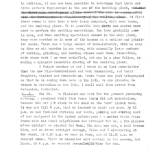 May 16
May 16
We finished our work for the present yesterday morning. A promised visit from Peake Pasha did not materialize, because his car got stuck in the sand on the “new” Arabah road. It was not till 8 p.m. that we learned he could not come. By 12 p.m. we had finished striking our tents, packing and storing most of our equipment in the Aqabah police-post- a matter which Peake Pasha with his usual helpfulness had arranged for us. A few minutes after midnight we started for Maan. The moon was out, a cool breeze blew, and we drove straight through, Ylias and I alternating at the wheel. At 4:30 a.m. we were in Maan, and at 11.30 a.m. we reached Amman. There we deposited more pottery in the museum, had lunch. At 4 p.m. we reached Jerusalem, in time for tea.
Bombing and shooting broke out again today, partly in retaliation probably for murders of yesterday. Curfew on again tonight. Had to push supper back to 6:30 to allow the servants to get home.
May 26
Harding dropped in on his way to London. Wordsworth, barbers [?] for chance to meet Winnetts.
May 27
Bellerby left for his horseback trip through Turkey. Dominicans and Meyer to meet Winnetts.
May 28
Telegram saying I get a 4th year’s leave of absence. Monto family arrived. He was superintendent of a district of schools in Philippines; Mrs. Monto principle of a high school.
—June—
Mrs. Elihu Grant called. Tea for Winnetts. Guests included Dr. and Mrs. Canaan, Sheikh Yoqub Bukhari, and Dr. Sukenik.
June 4
Went with Winnetts and Fisher to call on Sheikh Yoqub Bukhari, and Sheikh Khalil el- khaldi, the former president of the Shari’a Court.
June 5
Called on Sheikh Yoqub Bukhari and Sheikh Khalil el- Khaldi, the former president of the Sharia court, at the mosque. Sir Flinders Petries celebrated his 85th birthday.
June 7
Sheikh Khalil el-Khaldi, Sheikh Yoqub Bukhari, and Mr. Farid Imam called on me.
Helen and I attended King’s birthday party at the High Commissioner’s.
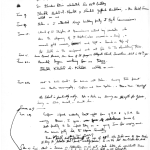 June 10
June 10
Church of St. Stephan at Dominicans entered by vandals who stole the reliquary of St. Stephen (a bone encased in a box), and several gold crosses, and left a bomb on top of the hill in the compound and set fire to the shrubbery there.
June 15
James Edward Hanover, Honorary Ca[?] at St. George’s Collegiate Church, Jeruselem, died in 88th year.
June 21
Herschel began working for me today. Sheikh Khalil el-Khaldi called on me.
June 23
Went to A.P.S. Clark’s for dinner with Helen. Among those present were Bertha Novomeysky, Captain and Mrs. Norton, and Mr. and Mrs. Moody. The School is practically empty. Pape and Fisher are leaving on the 29th for Cyprus, leaving on Petris, Wambold, – Winnets here.
June 27
starb im Sarona im Altersheim, we sie seit, Jahr lebte die verwitwete Frau Rosa Stahel, geb. Mayer aus Steinbeck bei Schwäbisch Hall im 85 Lebensjahr.
—July—
July 4
Returned from Heifa and Tel-Aviv where we went to meet Elumm Basly, Sally, and P.Polesky. Curfew again tonight.
Curfew still continuing. The condition has deteriorated to the worst stage of the 1936 riots.
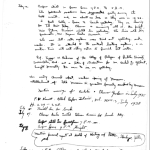 July 12
July 12
Curfew still in force from 7P.M. to 5A.M. The political conditions have degenerated greatly during the last month, and are almost as bad as they were in 1936. I took Sally and Pessa to Jericho yesterday. They are leaving for Tel Aviv today. Eleanor is remaining with us. Miss Fatima Husseini waited here yesterday. She lives with her grandmother, Mrs. Kazam Pasha Husseini. The new hot-water system was tried out yesterday, and works. It is attached to the central heating system, and in winter-time will cost nothing extra to furnish hot water. Professor Torezio with Nakarai of the College of Religion of Butler University, Indianapolis, Ind. And a letter of introduction for Miss Vechel G. Gilbert, brought personally. He came to see me yesterday. When writing Annual report, mention opening of Museum, establishment of Folk Museum in quarters formally occupied by Museum. Mention marriage of Nichols and Eleanor Graham in July 1938 F.V. Winnett: Allah Before Islam, vol. XXVIII : 3, July 1938 pages 239-248.
July 15
Thiswall here for lunch.
Eleanor Bisbee invited Fatima Husseini for lunch today. Curfew still in force from 7 P.M. on.
July 19
Curfew from 9 P.M. tonight. Mention personal regret at deaths of Warburg and Patten, Starkey, Yellin, and [?] [entry incomplete]
July 20
Wheaton College group phones at last minute that they would arrive Friday noon.
July 22
The Wheaton College group, 21 strong, arrived this noon. Mr. and Mrs. and Miss Friad also stayed here for lunch.
July 29
Wheaton College group left this morning for Egypt, somewhat sooner than they had expected. It was a nice group. I gave three lectures, and Sir Flinders one lecture. Pere Vincent was here this afternoon. He examined the pottery, and felt that it could be dated from about the twelfth to the seventh century B.C., which is in agreement with what Fisher and I had independently agreed.
July 30
Lectured to Wheaton College Group.
July 31
Mrs. Vestin, Mr. and Mrs. Goldwater, Mr. and Mrs. Guy here for tea.
—August—
August 2
Left for T.J. with Winnett and Ylias.
August 6
Returned last night, having been called back from T.J. because of Helen’s illness.
August 9
Miss Rosenthal left on her vacation.
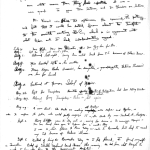 August 14
August 14
Mme. Kazam Pasha Husseini, her daughter, and granddaughter, Fatima Husseini were here for lunch.
August 18
Lectured at Norman School of Mi[?]erins.
August 20
Left for Transjordan. Hamilton appointed Director of Antiquities, had been Acting Director once Richmond retired.
August 27
Returned from Transjordan- Helen in bed again.
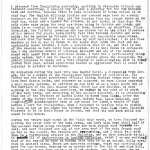 August 28
August 28
News Letter, No. 6.
I returned from Transjordan yesterday, arriving in Jerusalem without any incident occurring. I usually try to pick a Saturday for the run between here and Jericho, because there is less likelihood of being sniped at on that day. The English military lorries and armored cars have no special business on the road that day, and the lorries from the Potash Works on the Dead Sea, which are a magnet for attacks, do not travel on that day. The only other cars using the road are those going to Jericho and Amman, and there is no special reason shooting at them. However, my chauffeur, Ylias Tutunjian, the faithful Armenian who has worked for me and other Directors of the School for years, makes pretty fast time between Jericho and Jerusalem. Let me assure my friends that I take all reasonable precautions, whether or not my car is known to the bands that watch the road and occasionally cause trouble. I have a suspicion that it is, and that is one of the reasons we have never been molested. It is well known in Jerusalem that the American School of Oriental Research and all of its members stand well apart form the political scene. I have not a particularly phlegmatic nature, but I see no reason to get panicky about the situation. The School proposes to carry out a full program of archaeological work in Transjordan this year, unless conditions become so aggravated that it would be suicidal to attempt to continue.
My companion during the last trip was Rashid Hamid, a Circassian from Jerash, who is a member of the Transjordan Department of Antiquities. His father was the chief government official during Turkish times over the entire Beni Hassan tribe, and wherever we appeared, we were always accorded a most hearty welcome. In addition we had with us as a local guide one of the Mukhtars of the Beni Hassan tribe, which has six Sheikhs. We were working in the Beni Hassan territory, or rather in the part of it south of the Wadi Zerqa, and extending to the es-Salt district. It is interesting that one of the brothers of Rashid Hamid is named Musa Kazam, after the uncle of the former Mufti in Jerusalem. Madame Musa Kazam Husseini, her daughter, grandson, and granddaughter were at our house for lunch, a couple of days before I left for Transjordan. When I happened to mention this to Rashid, he told me how on the night his brother was born, Musa Kazam Pasha Husseini happened to be in their house in Jerash, and that the new born child was named in his honor.
During the twelve days spent in the field this month, we have finished exploring the south side of the Wadi Zerqa, and have also done about half of the es-Salt region going westward from the main Jerash road towards es-Salt, and have finished now all of the area east of the main Jerash road as far as the desert. The results are interesting, and I shall deal with them in a forthcoming article in the Bulletin, and go into complete detail in III of Explorations in Eastern Palestine, which I am now writing. Most of the region we were in during this trip is in an upland, hilly area, rich in ancient sites. There are numerous springs, which was particularly good for our horses, because we no sooner got to the top of one high hill, than we had to get down again and climb another, and the horses and we needed a lot of water. We usually walked the horses down-hill. The mosquitos were pretty bad several nights, but I simply put my abbaya over my head, because I consider it preferable to be half smothered, than to get malaria, which, by the way, many of the natives still consider to come from the hot winds which blow occasionally.
During the first four day trip this month, I had the pleasure of having Dr. F.V. Winnett, of the University of Toronto, with me on the part of the survey from Sukhneh on the Wadi Zerqa to near the Jerash bridge which used to cross the Zerqa, before a spring freshet washed it away. Mrs. Winnett and their son Billy had previously gone on to India, Dr.Winnett leaving several days ago to join them.
The Wheaton College group was here for a week during July, and it is one of the nicest groups that we have had here during the summer. Despite the difficulties of travel which prevail in Palestine today, they got around considerably, and saw almost all of Jerusalem that they would normally have been able to see. I gave three lectures, and Sir Flinders Petrie gave one lecture to the group.
Sir Flinders Petrie celebrated his 85th birthday recently, and wants to excavate again next year.
There have been few visitors this summer, and the Hostel has been practically empty since the Wheaton College group left. Few tourists have the temerity to visit Palestine these days. The usual number of professors and other members of institutions affiliated with the American Schools of Oriental Research who during past summers have made our School their headquarters, have not come to Palestine this summer.
Among visitors who have called at the School recently are:
Mrs. Elihu Grant Squadron Leader and Mrs. Horn
Sheikh Yaqub Bukhari Mr. and Mrs. M. Novomeysky
Sheikh Khalil el-Khalidi Dr and Mrs. Max Schloessinger
Mr. Farid Imam Mr. Blatchford, American Vice-Consul
Pere Du Vaux Mr. and Mrs. P.L.O. Guy
Pere Vincent
Madame Musa Kazam Pasha Husseini and Family
Dr. and Mrs. Judah L. Magnes
Mr. and Mrs. H.J. Iliffe
Mr. L. Harding
Mr. Bishop of the Newman School of Missions
Mr. George Wadsworth, the American Consul General
Dr. Eleanor Bisbee, Professor of Philosophy at Robert College, Istanbul, is spending the summer here as the guest of the Director and Mrs. Glueck.
The Director gave a lecture on archaeology to the students of the Newman School of Missions on Aug. 18. A short article on the excavations at Tell el-Khaleifeh has appeared in the July 30, 1938 number of the Illustrated London News. Other articles on the same subject will appear in the September numbers of Asia and Antiquity, and in the October issue of the Bulletin of the American Schools of Oriental Research.
August 29
A new stunt. The Arabs are making all Arabs wear Kafias and Agals, as to confuse the police who could partly recognize TJ or other Arabs by non-Tarbiah, et., headgear.
—September—
Harry Iliffe came to stay with us, arriving for dinner in the evening. Maryoni and their son David have gone to Cyprus for a month’s stay. I was to have flown to Rome today en-route to Brussels, but had to cancel my trip because of Helen’s illness.
September 5
Instead of being in Brussels today as I had planned, I found myself in Jerusalem. Picked up Sheikh Mahmud Daud Ansari this morning. He had been shot through the neck. I brought him to the government hospital.
September 7
Went to Rotary meeting. Played tennis with Keith-Roach and Lawsons.
September 9
We have a man from Medis, caulking up all the cracks in the floors and sides of the doors.
September 9
The Petries ate lunch here, but will not be here for dinner, and are spending all day tomorrow out, and are sleeping out tonight and tomorrow night.
September 11
A 15 minute volley of shots by rifles and machine-gun in wadi back of School this morning at about 7 A.M. Eleanor Bisbee leaving this morning for Ludd, taking airplane to Haifa.
September 15
My secretary’s father, Dr. M. Rosenthal, shot dead yesterday in Ramle while returning in his car to Jerusalem from Tel Aviv. Abraham Bergman miraculously saved when land-mine exploded his car, killing three and wounding one in it. I take it he was driving. He is our former Thayer Fellow. We are still fumigating after the Petries, The cracks between the tiles, etc. in Hostel building are being repaired.
September 16
Letter from N.Y. Times Sunday section, accepting article; letter dated Walter B. Hayward, and dated 1/9/38. Mr. James A. Mills and Harry Zimden of Associated Press of America called this morning, and I spend several hours showing them around. Over 100 casualties in air-engagement with band near Ramallah yesterday.
September 20
Miss Rosenthal returned this morning.
September 22
Dr. Magnes has rented a room to be able to read in quietly. His is studying Jeremiah.
September 23
Bands burned down all public buildings in Jericho last night. Sir Flinders Petries returning to School this afternoon. Mr. Blatchford of the American Consulate called, to get the names of the Americans resident here at the school, in case we had to be evacuated.
September 25
Speaking to Sheikh this morning, he told me how the Christian villages of Ramellah, Bir-Zeit, and Jifreh are suffering from the repeated ersets [?] of the bands, who force contributions of food, money, and rifles. The bands speak of these villages as Ramalleh = Bagrah Hallandiyeh (gives a lot of milk). Bir-Zeit = [Bagrah] Beirutiyeh (gives less milk). Jifreh = [Bagrah] Baladiyeh (least milk). In T.J. the other day, Rashid explained that England is waiting till the Arabs who have become rich from the Jews, become poor again, when it will be easier to handle them, because a rich Arab is supposed to be an obstreperous one. According to the Arab phrase which he quoted: If an Arab has money, he does one of three things: a. He gets a new wife; or b. he buys a new horse, or c. he starts trouble.
September 26
First drops of rain this afternoon.
September 27
I have let Umm Isa go, giving her a month’s extra salary. From about 12:00-12:30 P.M. an Arab woman sat on left side of main gate, as one waits, observing the house, (?), or perhaps merely waiting for something outside.
September 28
Dr. Herschel’s car shot at 7:40 A.M. this morning on way to Museum, while passing in front of former house of Chief Secretary. One bullet hit the car. No one hurt. In it was his wife, Miss Aaron [?], my secretary- Miss Rosenthal, and Henachel [?].
September 29
Mr. Ellerman arrived yesterday afternoon.
September 30
Mr. and Mrs. West arrived for lunch today.
—October—
October 1
Ramallah, Bethlehem, Jericho in hands of bands.
October 2
Umm Rash Rash abandoned.
October 10
Classes begun. Petrie’s camp at Gaza burned down.
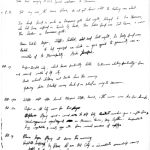 October 13
October 13
A.M. Shot at bend around our property turning from Saleh. Ed. Din road to road going to Museum at Neskei Taxi carrying P.W.D. Jewish workmen to museum.
P.M. Shot very near the same place; do not yet know what the shooting was about.
Two heads found in sack on Damascus gate last night; belonged to two Moroccans who had been captures in Jericho by bands, their bodies found near Tul Kaum, and now their heads on Damascus gate.
Hasan Sidki Dajani, Iliffe’s landlord, shot dead last night, his body found near Ramleh. He had organized car-strike in 1936 against the government; was a councilor of the municipality. Arabs terrified.
Planes began flying at dawn this morning. Pamphlets dropped by planes all over Old City and immediate surroundings warning people to stay inside their houses. Iliffes and other English evacuated from behind us near Wadi-Joz and have gone to Y.M.C.A. I went to meet Meah Shearim to buy vegetables, because servants afraid to go out after all the shooting of yesterday and the pathnuze closed Arab shops nearby. Airplane buzzing overhead, and the machine-guns very lights, some of the bands escaped but might repeat over Harod’s gate. Boy Scouts could do better than the English.
Curfew in old city, which lands practically hold. Continuous shooting practically from and around walls of old city. Arab school-children went back home this morning. Yesterday kids blocked convoy back of my School on way to Museum.
Iliffe left after lunch. Marjorie Iliffe, David and the nuns were here for lunch.
October 18
Curfew in Old City now for two days. Airplanes flying round and round over the old city. Constant machine-gun and rifle fire; machine gun and signal-squad on Museum tower; very lights. Impossible to buy vegetables and meat, eggs etc. from normal sources of supply.
News-Letter 7.
My last news-letter was not unduly optimistic, but I did not dream that the political situation in Palestine and the lack of public security already become well nigh intolerable, could within a few days become radically worse. All thought of returning to Transjordan had to be given up when the Government vacated the police-posts between here and the Jordan, and the bands took over Jericho, and celebrated their control by burning the public buildings there. Ramallah, Bethlehem, and up till a few days ago even the Old City of Jerusalem passed into their hands, not to speak of most of the rest of the country, where strong Government forces and armed residents were able to maintain order. Reports of savage attacks on peaceful citizens, accounts of the uprooting or cutting down of thousands of trees and of the gutting by fire of practically every Government agricultural station, not to speak of other public and private properties, compose the fare served up to us in the official communiqués.
Meanwhile, the students of the School arrived, namely the Thayer Fellow, Dr. Harold Glidden and his wife, the Two Brother Fellow, Mr. Donald West and his wife, and Rev. Ellerman. Class-work began on October 10th, and I have not known a nicer or more enthusiastic group at the school during previous years. There is much work to be done here at the School, actually handling archaeological materials, in addition to the formal lectures which are being give. Professor Fisher has always been most helpful. Up till now there has been no possibility of traveling around the country. Indeed, no one has been allowed to leave our grounds unless I was previously informed, and gave my approval. I have taken the students around Jerusalem in the School car as much as possible. They have all been good sports about the situation. The tennis-court has been of much help, and we have not missed a morning even during the last few hectic days.
Within the last few weeks, English troops have been poured into the country. Two days ago, the recapture of the Old City of Jerusalem was undertaken. I shall let the newspaper headlines tell the story, – or some of it.
October 18 CURFEW IN JERUSALEM.
October 19 JERUSALEM PUT UNDER MILITARY CONTROL
October 20 TROOPS OCCUPY OLD CITY OF JERUSALEM.
RAPID AND SYSTEMATIC ENTRY.
CORDON ROUND HARAM AREA.
ACTION TO CONTINUE TODAY.
These are the headlines, and I could write reams abut what has actually gone on behind them. Two days before the troops entered into the Old City, there was an incessant buzzing of airplanes overhead as they circled round and round the Old City, and dropped pamphlets warning the public to keep away from the walls, in as much as the military intended to take action. The tower of the Museum, a few minutes walk from our grounds, occupies a strategic point, and commands a view over much of the old city. There are about seventy five soldiers billeted in the Museum, and there are four machine guns on the tower. The soldiers fire at anybody who pokes his head above a wall in the Old City, and the members of the bands in the Old City return scattered rifle shots. The lads behind their machine guns on the tower of the Museum let fly apparently at the least provocation. There are other similar posts all around the walls of the Old City, and for two days before the troops entered, there was an incessant roaring of the airplanes, a continuous rat-tat-tat of the machine guns, sharp explosions of rifle fire, and the occasional bursting of a bomb. Most of this has stopped since the troops entered into the Old City yesterday, and there is much hope now that order will be restored. Long before this letter reaches its destination, the world public will have learned what has happened. The fracas is by no means over. As I write there is a burst of machine-gun fire somewhere near Herod’s gate, and Verey lights are being shot off from the Museum tower to illuminate the wall of the Old City opposite it, and can prevent any of the members of the bands from escaping. It can, however, only be a matter of a day or two before the military have the situation completely in hand.
Meanwhile, we at the School are cut off from the usual source of our supplies of meats and vegetables. No one can enter or leave the Old City, where our cook Shukri used to make these household purchases. All of the other Arab shops outside of the Old City are closed, only about one eighth open, which means that you have to sneak around the back way to get in and make your purchases. In addition, our servants are terrified at leaving the grounds, and so for the last few days, I, perforce, have been doing the shopping in various quarters of the town. A candid shot during the last few mornings would have revealed the Director of the School buying carrots for instance, and saying to the vendor, “no, I think you’re charging me half a piaster too much.” However, thus far, I have, so to speak, succeeded in bringing home the bacon.
The rest of the country has become markedly more quiet. The main highways are being heavily patrolled by the new troops, and it is again becoming possible to travel between the main towns with a reasonable degree of safety. In fact, I have arranged for the students to take a trip to Syria, to visit archaeological sites there, and Dr. Fisher has kindly consented to conduct them this time. They are going in the School car, and our faithful Ylias Tutunjian is driving. They will be gone about a week, and I am hoping that soon after that, we shall be able to go to Transjordan again. On the whole, I feel, that we shall be able to carry out most of the program of work, particularly in Transjordan, that we have planned for this year. It is our hope and prayer, that after civil order has been reestablished in this country, all those concerned with its welfare may come together in council tempered with reason and charity, and find a way towards lasting peace.
October 21
Shooting still going on in and around Old City. Soldiers stationed in Attorney General’s house, a few metres north of us, has been sniped at from the cemetery by Herod’s Gate. He came over to get field-glasses, but I didn’t have any. At my suggestion, he has crawled on top of the ground in the Dominican’s grounds, which commands the cemetery. The School let for Haifa and Beirut this morning with Dr. Fisher, Ylias driving.
October 22
Old City opened today between 10 A.M. and 4 P.M. Hundreds of Moslem families evacuating the Old City
October 24
Everyone traveling outside of city required to have pass.
October 26
Rotary Club. Obtained Special automobile pass which every adult man must have who wants to drive a car in Palestine. The bands have announced they will kill any Arab who obtained such an identity card! Hundreds of Moslem Arab families moving out of the Old City. Tense atmosphere there!
October 28
School returned from Syria.
—November—
This is the second day of the Arab general strike, which is not actually a thorough one. Abul Bazzak, the self-styled commander of the section of Palestine, has written a letter to Americans, and Wadsworth in particular, denouncing Americans for espousing cause of Jews in Palestine, and threatening upheavals, including a), destruction of American property, b) boycott of American goods, c) withdrawals of pupils from American Mission Schools, d) taking of all ‘portable’ American property, whatever that may mean.
November 3
Heavy rains last night and today.
November 4
General strike. Mrs. West finished tracing the maps for me.
November 5
Heavy rain. Arab stores opened.
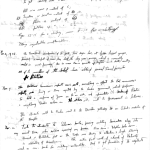 November 7
November 7
Traffic strike still on. No Arabs traffic, in as much as Arab drivers refuse to get identity cards and drivers’ cards. The food prices are rising catastrophically.
Rotl rice now 8 instead of 5;
Rotl tomatoes 15 piastres instead of 10.
Rotl flour 8 instead of 6.
Rotl potatoes 4 “ ” 2 ½
Eggs 13-15 for a shilling, now 8-10 for a shilling. Many vegetables un-obtainable.
November 8
The torrential downpours of the past three days have, at Lydda Airport guages, provided a rainfall of more than half the long year’s average, which is normally washed in mid-January; there is more than a quarter of the year’s rain in the hill country. All of the members of the School have obtained general Travel permits for Palestine.
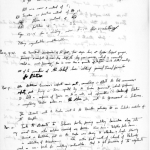 November 9
November 9
The Palestine Commission’s report came out, cancelling in affect the Peel Commission’s report, and being in turn rejected by the London government, which proposes to hold a conference of Jews on the one side, and representative Arabs of Palestine and neighboring Arab rulers on the other side, with the government in between. The students with Dr. Fisher went to the Musistan yesterday to see Schick’s modes of the temple.
November 11
Took the students to Solomon’s pools, passing military barricades along the way several times, where soldiers examined our passes. Wires down and telephone poles down, arrived in Bethlehem just as the Troops were standing to attention and bugle blaring in celebration of armistice. The entire front court of Church of Nativity used as car-park for military automobiles. Had to get permission of the adjutant to get in.
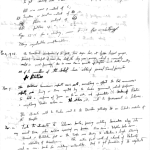 November 12
November 12
Drove Gliddens to Jaffa to get their baggage out of customs house, where it had been lying for weeks and no one could move it because of the Arab car strike. The day before there had been curfew in Jaffa. It was Saturday, practically only military cars on the road.
November 13
Sunday Fisher took students to Virgin’s tomb and Gethsemane. Shooting again last night. After hour curfew in Museum quarter.
November 14
Jericho recaptured by the troops.
November 15
Fisher took the students into the Old City again this morning, among other places to Church of Holy Sepulchre. Vincent came over to tea, and showed them the grounds of St. Stephen’s.
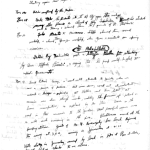 November 16
November 16
Took students to museum. Iliffe showed them around workshop, and showed them Gower’s workshop, where Gower and assistants are repairing mosaics. Fakhri Bey Nashashibi wrote to a letter H.E. published in Palestine Post attacking Haj Amin Effendi Husseini, and saying that his group would be glad to support the government.
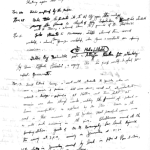
Jorrid [?] Potash Convoy and went with students to Jericho, where we saw a parade of prisoners. All wires down; road out at important culverts, bridges and repaired. At Kallia went there ___. At concession were shown through works watching the processes of Potash and bromine manufacture, as explained by Mr. Stein. Drove on the road in the concession to the Jorday. Most peaceful scene was a wild duck swimming in the river. Blockhouses around all the pumping stations. Guests of Mr. M. Novomapsky for lunch rejoined the convoy at 3 P.M., arriving in Jerusalem at 4:30. Water shortage in Jerusalem, caused by leak in pipes at Ras el-Ain, does not affect us thanks to our cisterns.
November 18
Purchased cold-frame for the garden.
November 18
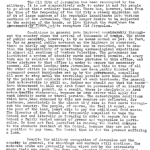 News-Letter No. 8. [printed document]
News-Letter No. 8. [printed document]
Jerusalem
The Old City of Jerusalem has been reoccupied by the military. It is now comparatively safe to enter it and for people to go about their ordinary business. There has, however, been from the time of the reopening of the Old City a steady migration out of it of large numbers of its reputable inhabitants into various sections of new Jerusalem. They no longer desire to be subjected to the mercies of the bands, or live through the days when the government had by force to recapture Old Jerusalem.
Conditions in general have improved considerable throughout the country since the arrival of thousands of troops. The state of public security, however, is by no means normal as yet. In fact, so far as general public movement on the highways is concerned, there is hardly any improvement that can be recorded, not to mention the impossibility of undertaking archaeological expeditions in almost all sections of Western Palestine. The government has instituted a system of identity cards and travel permits. At every turn one is required to hand in three pictures to this office, and three pictures to that office in order to secure the necessary passes. All roads leading into Jerusalem, and this is true of all the other cities in Palestine, have now been partly blocked by permanent cement barricades set up by the government, compelling all cars to stop until the travelling permits have been examined by the police and soldiers stationed at each barricade. The general Arab motor-strike is still on. Rather one should say that the bands have threatened to kill any Arab found in possession of an identity motor-traffic whatsoever, because no Arab driver will apply for such identity cards or travel permits. The catastrophic conditions which have been enhanced by this new measure are reflected, for instance, immediately in the almost 40% rise in food costs throughout the country. The people, of course, who feel it worst, are the poor of the land, least able to pay the additional food costs. The Director of the School is frequently compelled to take the School car and literally go foraging in order to secure for the School a fairly varied amount of greens and vegetables in particular. He does not feel justified in raising the Hostel charges to the students resident at the School, because they are not in a position to pay them. The Hostel thus is for the present suffering a loss.
Despite the military occupation of Jerusalem and the country in general, the shootings and murders still continue. The moderate Arabs are gradually being wiped out by the extremists among their own group. Two days ago, another Nashashibi was shot at not far from our grounds, fortunately escaping, and yesterday one of the professors of the Rashidiyah Boys School, was seriously wounded while on his way to School. He too, was one of the moderates. It is sad to know that even if complete
peace were to be established tomorrow, there will be blood-feuds among many of the leading families of Palestine, lasting for years to come. The relatives of the murdered will not forget. Some of them have told me so. For those who have long resided in this country, the abnormal seems to have become the ordinary. Thus last night, when rifle and machine gun shots were heard from a not very great distance, one said merely: “Ah yes, they’re at it again.” The solution to the Palestine difficulties so hopefully prayed for by all of the world as a result of the long delayed Report of the Woodhead Commission has not come about. In effect, this Commission “repealed” the Report of the previous Peel Commission, and at least for the present, no positive step forward towards restoring real lasting peace in this country has been taken. Thus Commissions come and Commissions go, and confusion- goes on for ever?
Let those, however, who live afar not cavil at conditions here. Palestine is a very ife part of the modern world. It reflects its enthusiasms and interests. It mirrors its foibles and faults. European civilization has its counterpart here in all of its aspects. Only here it seems the good and the bad are enhanced or aggravated in the rarefied atmosphere of this unholy Holy Lang. How sad this sacred land cannot give examples instead of taking example from countries which should by quarantined with the red flag of contagion.
Despite, however, the lack of peace, and the troubles which plague Palestine, the work of the School has suffered no real break. It must not be imagined that we sit and mope all day long, or that we are afraid to venture out of the grounds of the School. First of all, beginning on October 10th, regular lectures have been going on to the members of the small, but excellent and capable and enthusiastic student body. Dr. Fisher has been of great assistance to the Director. Whenever conditions have permitted, the students have been taken either by the Director or by Dr. Fisher on trips, or with the Director’s permission have gone out occasionally alone. No one from the School moves without that permission. On October 21st, the entire School under Dr. Fisher’s guidance left for a trip to Syria. They remained there for a week, seeing Beirut, the Dog River, Byblos, Tarius, Crao de Chevalier, Daphne, Antioch, Aleppo, Baalbek and Damascus. With the Director or with Dr. Fisher, they have now seen most of the places of historical interest in the Old and in the New City of Jerusalem. On November 11th, the Director drove the members of the School to Solomon’s Pools. Any trip these days has its somber aspects. First of all, the formality of getting in or out of the city; then being stopped numerous times along the road by soldiers who examine the travel permits; seeing all the telephone wires down; the telephone poles uprooted; and in numerous places the roads poorly repaired where they have been out or dynamited by the bands. Returning from Solomon’s Pools we drove to Bethlehem, arriving at eleven in the morning, just the large contingent of British soldiers stationed there was celebrating the declaration of armistice in November 1918. Shdes of the peace which was then established! The entire front courtyard of the Church of Nativity has been transformed into a military oar-park. It was necessary to secure permission from the Officer in
Command in order to enter the church, which was empty of worshippers. The blackened ruins of the post-office building immediately opposite the church testify to the recent occupancy of Bethlehem by one of the banc[?] The pathetic store-keepers in Bethlehem who are dependent upon tourist trade practically swooned when they saw a carload of visitors drive up. The finances of the students, however, did not permit them to make any purchases, and we were forced to drive away, leaving the store-keepers almost in a state of collapse. On November 12th, we drove to Jaffa, partly in order to see the country on the way and give the students and opportunity to take photographs, and partly in order to get the baggage belonging to Dr. and Mrs. Glidden out of Customs, where it had been gathering storage charges for several weeks. Because of the transport conditions it is almost impossible to send baggage to Jaffa or to receive it from there. On November 17th we joined the convoy and drove to Jericho and the Dead Sea. We only remained in Jericho for a few minutes, because the military having just a few days previously reoccupied the town, were parading over a hundred prisoners through the streets. We then drove to the Dead Sea. In the grounds of the concession area of the Palestine Potash Company, we were hospitably received by the representatives of the Director of the Company, Mr. M. Novemeyski. It was a pleasure to see hundreds of Jews and Arabs working together in perfect harmony. We were shown through the works, and then following the road which leads through the area, drove down to the banks of the Jordan. For lunch, we were the guests of the Director, to whom and to whose representatives we are most grateful for their gracious hospitality. Before lunch the member of the School had the experience of bathing in the Dead Sea. The Director is planning shortly to take the School for a trip to sites of archaeological interest in Transjordan. He would have the constituency of the Schools feel assured that no trips are taken unless there is practically a certainty that they can be made safely. The Director make it his business to be informed of what is going on, and receives information from various friends of the School.
Thus far, thank God, it has been possible to maintain the widely respected neutrality of the School. A member of the Nashashibi family is now one of our students. The Director does not know how properly to thank many friends of the School for assisting him in preserving the School’s neutral status. The exacerbated condition of the public nerves is reflected by the immediate reaction to the various factions in Palestine to statements from abroad favouring on or another of the issues at stake here. Let it most emphatically be announced again that this School has no partisan interests. We are devoted to scientific study and to nothing else.
As a result of the breakdown of the main pumping station at Ras el-Ain, there has been for almost a week now an extreme water shortage in Jerusalem. Due, however, to Professor Albright’s wisdom, when the School buildings were being constructed, of insisting upon large cisterns being made, we at the School suffer no inconvenience.
November 20
Vincent took School to Pontias Pilate’s place.
November 28
Returned today at 2:30 P.M. from Talghah, via Tiberias, Nazareth, Tabur, Afuleh, Jenin, and Nablus. Were stopped 15 times en-route by police and soldiers to show travel permits. Went up day before yesterday by same route, minus Tabur. Arrived in Taberias, but could not get gasoline; – Arabs not allowed to have any, and Jews closed on Saturday.
November 29
Students went to Mosque of Omar with Umsaibeh. [Students] walked around walls of city.
November 30
Sheikh Yoqub Bukhari, his son, and Dr. Hadj-Brix, and Nusaibeh here for tea.
—December—
December 7
Gave a lecture on “Palestine as a Trading Center in Ancient Times.” The Chairman of the meeting, held as the first of the season’s lecture of The Palestine Economic Society, was the Chief Secretary W.D. Battershill, Esq. C.M.G.
December 12
Atarah was married at 3:00 P.M. to Nimrud served by the Asnitai. Unfortunately, it developed subsequently, that Atarah’s father is Nimrud’s grandfather, which makes for a sort of a first cousin or sister to her husband.
December 14
The Arabs finally got Sheikh David Ansari on their fourth attempt, two days before he was to leave for the Haj to Mecca.
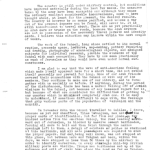 News-Letter No. 9. [printed document]
News-Letter No. 9. [printed document]
The country is still under military control, but conditions have improved materially during the last few weeks. The measures taken by the army have been energetic and although they cause the ordinary resident considerable inconvenience, seem to have brought about, at least for the present, the desired results. The country is however by no means pacified, and unless a way out of the present impasse can be found, will never be. It is still inconvenient to travel about. There are as yet practically no Arab cars or trucks on the roads, because the Arab drivers are not in possession of the necessary travel permits and identity cards. I believe this situation may improve within the next couple of weeks.
The work of the School, long since settled to its normal routine, proceeds apace. Lectures, map-making, pottery repairing and drawing, photography of archaeological objects, and assigned subjects for individual research, provide the students of the School with much occupation. They have by now seen practically as much of Jerusalem as they would have even under normal circumstances.
I am glad to say that the wave of anti-American feeling which made itself apparent here for a short time, did not extend itself generally nor prevail for long. None of our Arab friends severed their connections with the School or with any of its members. They continue to make use of our Library, and to foregather with us socially as before. If anything, during the period of the disturbances, there has been a marked falling off of Jewish visitors to the School, not because of any lessened regard for it, but because of what are considered the difficulties of getting to our quarter which is an almost completely Arab one. It is easy to understand, if sometimes difficult to cope with, the feelings that grip various parts of the population of Jerusalem and the country.
On November 26th the School travelled to Galilee. I drove, because as yet our chauffeur, Ylias Tutunjian, has not the proper cards of identification. Not far from our place, a few hundred metres from the American Colony, the road leading northward out of Jerusalem, is blocked by massive cement barricades, forcing all cars to halt and then twist through the narrow openings left in them. A detail of soldiers or police is stationed at this barricade, and all male passengers are required to show the proper papers. Our car, being well known, was not stopped at this place, but between here and Tabghah and the back, within two days, we were stopped no less than 30 times by the military in order to identify ourselves. On every strategic hill-top British military posts are visible. Troops man barricades set up at the entrance and exit of every town along the road as far as Tabghah. Military patrols pull up in fast armoured cars in between these
Barricaded roadstops, and ask for travel papers. For any group except our own travelling under these conditions would be more than an annoyance. My purpose, however, on this trip was to have the students see central Palestine, and part of Galilee. It made no difference to us how many times we were stopped, because it permitted the members of the party to photograph to their hearts’ content. As a matter of fact, we stopped at least as many times of our own volition for purposes of photography as we were halted by the military. On one occasion we stopped in order to enable the students to photograph some fellahin ploughing. They were using simple wooden iron-tipped ploughs, that have changed but little throughout the centuries, dragged in some instances by oxen, and in others by the “forbidden” combinations of a donkey and an ox. I repeat a conversation that I had with one of the fellashin who approached the car, because it is not uncharacteristic of the present temper of the country. He demanded bakhheesh, whereupon I asked him: “don’t you ever do anything for the sake of politeness?”; his answer was: “no, politeness is dead in the land today.” I assured him that that could not be so, that either we would photograph in the name of common courtesy or not at all. We photographed. We continued to photograph in Nablus, Jenin, Nazareth, Afuleh, Tiberias and Tabghah. In Afuleh we dropped in for a second to see Dr. Bergman, our former Thayer Fellow, who is now District Officer there, and Mrs. Bergman, formerly the secretary of the School. I am glad to say that he seems to have recovered fully from the harrowing experience he went through some months ago, when his car was blown up by a landmine, and several of its occupants killed. It was impossible to get to Capernaum, because that place has been wired off by the military, and the priest in charge, who happened to be at Tabghah when we arrived there, said it would be impossible for us to get in. I could possibly have arranged it by getting on the phone to Jerusalem, but it takes hours during these days to make a long-distance call even if the wires happen not to be torn down. We travelled up on a Saturday, and came back the next day via Mt. Tabor. We found a scene of humming activity when we got on top of the mountain, because a large new wing is being added to one of the buildings there. The church was opened up for us and we were conducted through it by an American priest. We returned early in the afternoon of the second day to Jerusalem in time for tea. I trust that those who read this letter will not regard our trip as having been unnecessarily dangerous. I made careful inquiries before I started out from competent authorities, who saw no objection to our undertaking the trip.
With the kind of permission of the Director of the Department of Antiquities, the master photographer of the Museum, Mr. S.J. Schweig is giving a course of lectures to our students on archaeological photography. They are exceedingly instructive lectures. On December 7th, the Director addressed the Palestine Economic Council on the subject of Palestine as an Ancient Trade Centre. Mr. Battershill, the Chief Secretary of the Government of Palestine, presided at the meeting. On December 19th, the Director will give the opening lecture of the year to the Palestine Oriental Society. There will be an illustrated lecture on Ezion-geber.
With gratitude that we have been able to weather the storms of the year now almost gone, and looking forward with hope to the year at hand for peace to come and work to be accomplished, all of us at the School send out best greetings to the School’s friends and supporters.
December 17
Arab buses and other motor cars began running today.
December 19
Lectured POS at Dominicans on Ezion-Geber; talked for 1 1/12 hours. Opening and sole lecture. Meeting mismanaged.
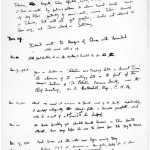 December 23
December 23
Nashashibi house back of of Matam’s shot at and bombed last night.
December 24
His nephew, 12 years old, was wounded today somewhere in the quarter.
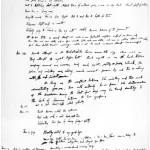 December 25
December 25
Had Xmas dinner in our house. Went to Bethlehem last night. Stopped twice by soldiers going, and on way back. Church full of soldiers. Xmas tree in living room. Knights arrived Dec. 23 from Egypt. Had to send taxi to Lydda for them. Ellerman left early in month. Probably going to Jeresh on Dec. 29 with Walsh, Economic Advisor of the government. At 8:30 P.M. a second attempt was made on our Nashashibi neighbor. A bomb was there, and then there were some shots, and a few minutes later some more shots, and some one yelling “Wier-u,” “where is he?” We’ll learn perhaps tomorrow morning whether or not this second murderous attempt was successful.
Fourth attempt on the Nashashibi house across the way. There was a third attempt the night before last. Each night we see the bomb-throwers escaping around our corners, and each night, after a proper interval, the police and military come along, m-[?] innocent passers-by, and then do nothing when the next incident occurs.
As long as the conflict between the military and the rival administration goes on, there will certainly be no peace. The deterioration of the disorders during the last few days may be traced directly to the lack of harmony between the two groups.
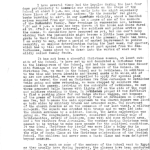 December 28
December 28
News-Letter No. 10. [printed document]
I have several times had the impulse during the last four days particularly to assemble our students on the steps of the School at about 8 p.m. and sing madly into the night especially those lines of our national anthem: “By the rockets’ red glare, bombs bursting in air”. In our immediate vicinity, about a hundred metres removed from our School, is a house of one of the members of the Nashashibi family. Four evenings in succession now, between 7.30 and 9 p.m. a bomb has been thrown at the house and shots fired at it. After a proper interval, the soldiers and police arrive on the scene. No casualties have occurred as yet, but one can’t help wishing that the Nashashibis might become a little less persona non grata to their fellows than they are at the present. There has been, I am sorry to say, after a period of market improvement in public security, and ominous deterioration during the last week. Our quarter, which has up till now been for the most part spared from the disturbances, seems about to be drawn into the vortex of what may be mildly called family feuds.
It has not been a cheerful Christmas season, at least outside of the School. We have set up and decorated a Christmas tree in the living-room of the School, and had the usual Christmas dinner with fixings at our house for all the members of the School. On Christmas Eve, we went in the School car to Bethlehem. In addition to the blue and brown identity and travel cards wit which all of us are now provided, we were compelled to apply for special pink slips to travel the road on Christmas Eve from Jerusalem to Bethlehem Twice going and once returning, we were stopped by soldiers who examined the passes. Arriving at the outskirts of Bethlehem, we saw three armored Rolls Royces with lights off on the side of the road and soldiers standing by them. In Bethlehem proper it was difficult to find a parking place for our Dodge station wagon, not because of the press of tourist cars normally found at Bethlehem on Christmas Eve, but because the main approach to the Church Square was lined on both sides by military trucks and armoured cars. The courtyard of the church remains as on the occasion of our last visit, a military car-park. The square was crowded with troops and we were led into the church entrance by a soldier. Inside, the Latin celebration was going on. The congregants, however, consisted practically only of Bethlehemites, crowds of soldiers, some with and some without arms, and a few visitors from Jerusalem. The weather during Christmas week seemed to be trying to make some amends for the political conditions. It was ideal. Christmas day itself was more like a balmy day in spring than in mid-winter. Mr. West, our Two Brothers Fellow, played the role of Santa Claus at the Christmas celebrations of the Swedish School. The children had never seen a Santa Claus and were delighted beyond measure.
In as much as none of the members of the School went to Egypt as they usually have during December, the classes have been conducted regularly, a recess being called only for the Christmas and New Year week. Mr. and Mrs. E.C. Knight have arrived and propose to stay at the School for about three months. Rev. F.C. Ellermann left early in December to resume his duties at his church in Syracuse, N.Y.
December 30
Reverend Dr. Carl Clemens Kopp called this afternoon.
December 31
Real wintry wind and cold have set in. Celebrating New Year by having fudge [?] -party.
